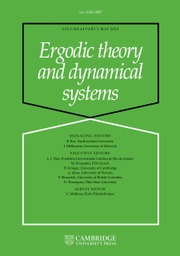No CrossRef data available.
Article contents
Minimal strong foliations in skew-products of iterated function systems
Published online by Cambridge University Press: 03 December 2024
Abstract
We study locally constant skew-product maps over full shifts of finite symbols with arbitrary compact metric spaces as fiber spaces. We introduce a new criterion to determine the density of leaves of the strong unstable (and strong stable) foliation, that is, for its minimality. When the fiber space is a circle, we show that both strong foliations are minimal for an open and dense set of robustly transitive skew-products. We provide examples where either one foliation is minimal or neither is minimal. Our approach involves investigating the dynamics of the associated iterated function system (IFS). We establish the asymptotic stability of the phase space of the IFS when it is a strict attractor of the system. We also show that any transitive IFS consisting of circle diffeomorphisms that preserve orientation can be approximated by a robust forward and backward minimal, expanding, and ergodic (with respect to Lebesgue) IFS. Lastly, we provide examples of smooth robustly transitive IFSs where either the forward or the backward minimal fails, or both.
Keywords
MSC classification
- Type
- Original Article
- Information
- Copyright
- © The Author(s), 2024. Published by Cambridge University Press



